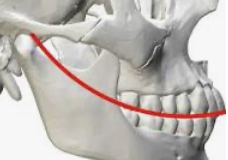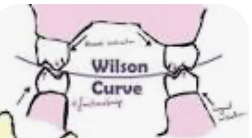Chapter 6: Occlusion
1/56
There's no tags or description
Looks like no tags are added yet.
Name | Mastery | Learn | Test | Matching | Spaced |
|---|
No study sessions yet.
57 Terms
Occlusion
Contact relationship between the maxillary and mandibular teeth when the jaws are in a fully closed position; as well as the relationship of the teeth within the same arch
Habitual way
Inter-arch
Between the two arches
Intra-arch
Within one arch
Occlusal trauma
A result of occlusal disharmony and/or injury resulting from excessive occlusal forces
Why we need orthodontists
Range of Movement
Many patterns of tooth contact and variety of range of movement partially due to temporomandibular joint (TMJ)
Occlusion Development
Occlusion develops in a child as the primary teeth erupt
Occlusion of erupting permanent dentition is dependent on primary teeth
Properly aligned teeth
When in proper alignment = self-cleansing by action of the cheek and lip musculature with the neutralizing flow of saliva over the smooth surfaces
When teeth are aligned, the dental arch shape is…
parabolic (parabola)
Misaligned Teeth
When teeth in detention are not aligned properly, there are imbalances or habits present = they lose the ability to self cleanse
May not be able to perform the functions in which they are designed
Centric occlusion
Position when jaws are closed
Habitual way the teeth come together
Position that allows the greatest interdigitation of the teeth
Related to the tooth occlusion
Tooth-to-tooth relationship
Determined by the way the teeth fit together
Other names for centric occlusion:
Habitual occlusion
Intercuspal position
Acquired occlusion
Convenience occlusion
Centric occlusion importance:
Creates proximal contact between neighboring teeth
Protects interdental papillae
Stabilizes each tooth in the arch
If contacts are open food gets impacted or “stuck” in between which can lead to trauma or irritation to dental papillae
During Centric occlusion - Since maxillary arch naturally overhangs the mandibular arch:
Each tooth in one arch is in occlusion with two others in the opposing arch
During Centric occlusion - Antagonists:
each tooth in one arch is in occlusion with two others in the opposing arch

*2 places that there is 1 antagonist
*mandibular central incisors and the maxillary third molars

In centric occlusion, he lingual cusps of maxillary molars and premolars rest in…
the occlusal fossa of the mandibular molars and premolars
The working cusps of maxillary arch
In centric occlusion, the buccal cusps of the mandibular molars and premolars rest in…
the occlusal fossa of the maxillary molars and premolars
The working cusps of the mandibular arch
**Supporting/centric/working cusps are the…
Buccal cusps of mandibular teeth
Lingual cusps of maxillary teeth
Incisal edges of mandibular anterior teeth
Guiding/non-centric/nonworking cusps are the…
opposite of the working cusps
Lingual cusps of mandibular teeth
Buccal cusps of maxillary teeth
Centric Relation is the…
Relationship of the mandible to the maxilla in which healthy muscles and bony contours comfortably guide the mandible into its most posterior position
Occurs during strong muscle contractions such as swallowing
When mandible is in the most retruted position to which it can be carried by the muscles and ligaments
Most stable and most posterior position
Repeatable/ reproducible
Jaw to jaw relationship
Muscle guided, not tooth guided relationship
Occlusal plane
Imaginary plane placed on the masticatory surfaces of each dental arch
*Curve of Spee
The curved alignment of all teeth when viewing occlusal plane of the mandibular posterior teeth from the buccal
Know definition and what it looks like (viewed from buccal)

*Curve of Wilson
The occlusal curve that exists for the posterior teeth from right to left
Know definition and what it looks like (viewed from anterior)

When a patient is closing in centric occlusion we will be looking for:
The horizontal overlap of the incisors and vertical overlap of the incisors
Overjet
How far out are the maxillary central incisors from mandibular central incisors
Horizontal overlap
*Only recorded if 4mm or more
If not then N/A
Over bite
Vertical overlap of anterior teeth
If maxillary and mandibular teeth do not touch but are widely separated when in centric occlusion
How much maxillary central incisors overlap the mandibular central incisors
How to measure over bite:
Have patient open
Measure entire mandibular incisor tooth length from the CEJ (CEJ does not change)
Have patient close
Measure how much of mandibular incisor is visible
Two types of overbite:
anterior open bite or posterior open bite
Anterior open bite
when person brings teeth together and only posterior teeth touching and anterior teeth are not, there is open space
Posterior open bite
when person brings teeth together and only anterior teeth touching and posterior are not there is an open space
Overbite causes:
Most often thumb-sucking, mouth breathing, sleeping with a bottle
There can be other causes
Edge-to-edge
When a person brings teeth together and anterior teeth of the maxilla do not overlap the anterior teeth of the mandibular arch but they meet and touch
An occlusion which the incisal edges of the maxillary incisors meet the incisal edges of the mandibular incisors when teeth are in centric occlusion
Edge-to-edge = anterior teeth
End-to-end
Posterior teeth
(cusp to cusp)
Crossbite
Malocclusion in which one or more teeth in the mandibular arch are located facial (or buccal) to their maxillary counterparts
Anterior or posterior
Unilateral or bilateral
Ex.) 3-30
Occlusal classifications can be ______ or ______
skeletal or dental
Skeletal
Relationship of none to the maxilla to the bone of the mandible
orthognathic/mesognathic, retrognathic, prognathic
Dental
Relationship of the teeth of the mandible to the teeth of the maxilla
Class I, II, III
Orthognathic/ Mesognathic
The upper jaw is in an approx. vertical relationship to the profile of the facial skeleton
Retrognathic
Mandible is posterior to its normal relationship with other facial structures
Prognathic
Mandible is anterior to its normal relationship with the other facial structures
Angles classification (dental)
Most popular classification system
Based on the relationship of the molars to each other
Basis of classification
1st molars
Canines
Can be used if molars are not present (crowned or in crossbite)
Class I (1)
The mesiobuccal cusp of the maxillary first molar is directly in line with the buccal groove of the mandibular first molar
Canine (if molars are not present)
Distal of mandibular canine within 1 premolar width of the mesial surface of maxillary canine
Class II (2)
Buccal groove of the mandibular first permanent molar is distal to the mesibuccal cusp of the maxillary first premolar by at least the width of a premolar
Canine
Distal surface of the mandibular canine is distal to the mesial surface of maxillary canine by at least the width of 1 premolar
Class II (2) has 2 divisions:
Division 1: anterior teeth are in alignment, may also include overjet
Division 2: anterior teeth are not in alignment
Max cent incisors are crowded, retruded, and inclined
Deep overbite in most cases
Overjet near normal
Class III (3)
Buccal groove of the mandibular fire perm molar is mesial to the mesibuccal cusp of the maxillary first permanent molar by at least the width of a premolar
Canine
Distal surface of mandibular canine is mesial to the mesial surface of the axillary canine by at least the width of 1 premolar
Considerations for classifications:
It is possible to have a mixed conditions
Difficult to tell the classification if the 1st molar is missing or crown is present, use canine instead
Displacements
If a tooth is out of alignment it can be either be pushed:
Lingually = linguoversion
Buccally = buccoversion
Mesially = mesioversion
Distally = distoversion
Infraversion
Torsiversion
Labioversion
Supraeruption/supra-erupted/supraversion
Intrusion/intruded
Transversion/ transportation
linguoversion
When a tooth has assumed a position lingual to normal
ex.) a tooth inside the arch formed towards the tongue
buccoversion
When a tooth has assumed a position buccal to normal
ex.) #2 buccoversion
mesioversion
When a tooth has assumed a position mesial to normal
distoversion
When a tooth has assumed a position distal to normal
Infraversion
When a tooth has assumed a position that is depressed below the line of the occlusion
Ex.) A tooth that has not erupted to the occlusal plane, a primary tooth submerged or ankylosed (attached to bone)
Torsiversion
A tooth that has assumed a position that is turned or rotated
Can be partial or full
Labioversion
A tooth that has assumed a position more labial to normal
Ex.) an incisor or canine outside of arch towards lips
Supraeruption/ supra-erupted/ supraversion
Tooth that as alonged above the line of the occlusion
Intrusion/intruded
Went back into bone
Ask the patient (otherwise cant tell)
Transversion/ transportation
Teeth are in wrong sequential order (wrong region)